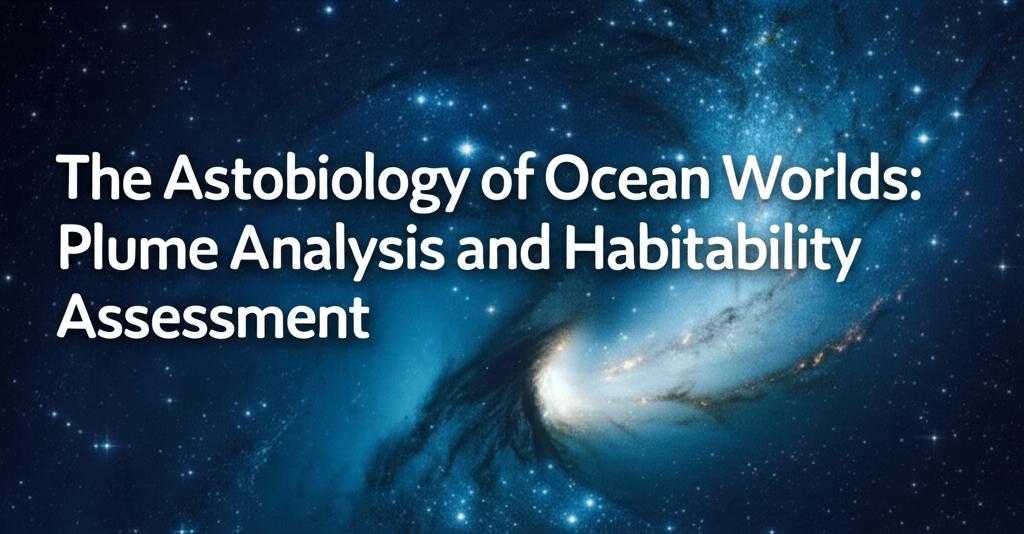The quest to find life beyond Earth has increasingly focused on the icy moons of our outer solar system, often dubbed "ocean worlds." These celestial bodies, such as Jupiter's Europa and Saturn's Enceladus, are believed to harbor vast liquid water oceans beneath their frozen surfaces. The potential for these oceans to host life has made them prime targets for astrobiological research, with a significant emphasis on analyzing plumes erupting from their interiors and assessing their overall habitability.
Ocean worlds like Europa and Enceladus are particularly compelling because they likely possess key ingredients for life as we know it: liquid water, essential chemical elements, and energy sources. The presence of global oceans in direct contact with rocky interiors on these moons offers the potential for water-rock reactions, which can produce chemical energy and release minerals crucial for life. Evidence even points to ongoing geologic activity, such as hydrothermal vents on the seafloor, which could create localized environments teeming with the necessary components for life's emergence and sustenance.
A critical aspect of studying these distant oceans is the analysis of plumes – jets of ice grains and water vapor that erupt into space from cracks in the moons' icy shells. These plumes offer a tantalizing opportunity to sample the subsurface ocean material without the immense challenge of drilling through kilometers of ice. Spacecraft like NASA's former Cassini mission at Saturn provided invaluable data by flying through Enceladus's plumes. Analysis of these plumes revealed the presence of water, salts, and organic molecules, including some of the basic building blocks of life.
Future missions, such as NASA's Europa Clipper, are being designed with sophisticated instruments to further investigate these plumes and the surfaces of ocean worlds. Scientists are developing advanced mass spectrometers and other analytical tools capable of detecting even minute traces of cellular material or complex organic molecules within single ice grains. The goal is to identify biosignatures – substances or patterns that provide evidence of past or present life. These could range from specific organic compounds and their ratios to isotopic signatures or even intact microbial cells.
Assessing the habitability of an ocean world involves more than just detecting water and organics. Researchers create detailed geochemical models to understand the conditions within these alien oceans, such as pH, salinity, and the availability of dissolved chemicals like phosphorus, another vital element for life. Recent modeling suggests that Enceladus's ocean, for instance, could be relatively rich in dissolved phosphorus. Scientists also study terrestrial analogue sites, such as Earth's polar regions and deep-sea hydrothermal vents, to understand how life adapts to extreme environments and what kinds of biosignatures might be preserved in icy conditions.
The study of plume composition allows scientists to infer the chemical processes occurring within the ocean, including potential water-rock interactions and hydrothermal activity. For example, the detection of molecular hydrogen in Enceladus's plumes points towards hydrothermal processes that could provide a chemical energy source for life, similar to how some microorganisms thrive in Earth's deep oceans.
However, the direct link between the observed plumes and the deep ocean, as well as the precise nature of the geophysical and geochemical processes sustaining these environments over geological timescales, are still areas of active investigation. Understanding these connections is crucial for determining whether these ocean worlds can provide stable, long-term habitable environments.
The ongoing exploration of ocean worlds, driven by advancements in plume analysis techniques and sophisticated habitability modeling, represents a significant step forward in our search for life beyond Earth. By comparing the conditions and processes on different ocean worlds, both within our solar system and potentially around other stars, scientists hope to understand the common principles that govern habitability and whether the conditions that allowed life to flourish on Earth are unique or widespread throughout the cosmos.

